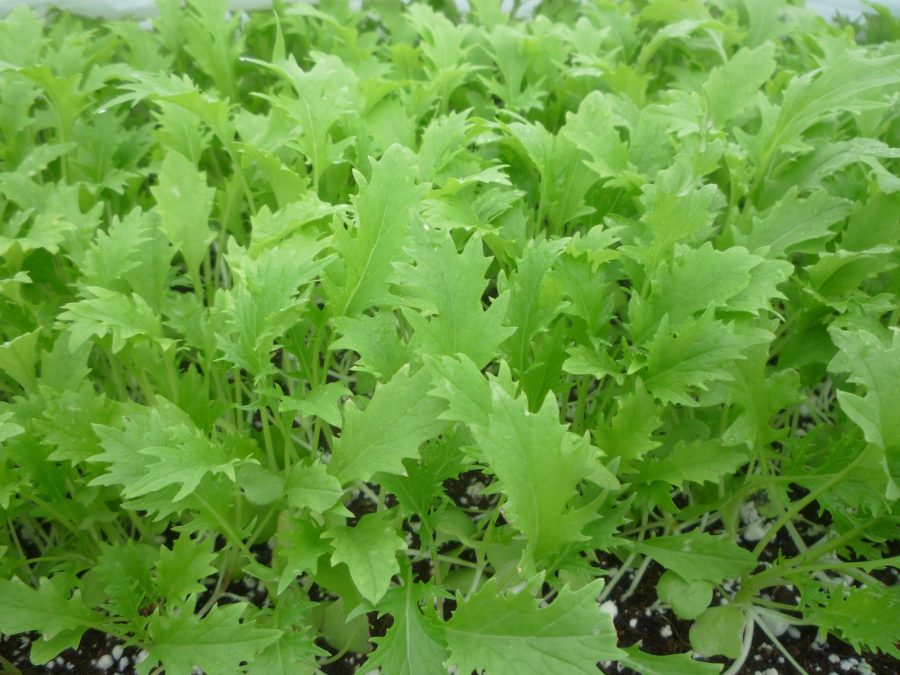This post contains affiliate links. If you buy something from one of our links we may earn a commission. Thanks

Do you know how to store microgreens properly? In this blog post, we will be discussing the best way to store your own microgreens so that they stay fresh and delicious and maintain all their health benefits. Keep reading to learn more.
Key Takeaways
How to Store Microgreens:
- Utilize a container with holes to allow airflow, preventing mold and rot.
- Place a damp paper towel inside to manage moisture.
- Store the container in the refrigerator at 32-36°F (0-2°C) to retain freshness.
- For longer storage, freeze the microgreens on a cookie sheet, then transfer to air-tight containers and keep frozen.
When it comes to storing microgreens, there are some simple tips and tricks you can follow.
My first tip is that some people recommend storing microgreens in an airtight container.
But you don’t want to do that. First of all, make sure you have a container that is not airtight.
One of the most important factors to keep microgreens fresh is that microgreens need some air exposure to stay fresh.
Otherwise, you might end up with a moldy mess. You can even store them in an open container with a paper towel on top.
If you use a plastic container make sure it is made from food-grade plastic. A glass container is an even better choice for storing microgreens.
A general rule for harvesting microgreens is to use a pair of ceramic scissors. This is recommended for cutting your microgreens.
Metal tools can interact with the cut end of the microgreens and may produce an off taste.
You will want to use the same methods of storing microgreens no matter what type of microgreen you are growing and also do the same to store baby greens.
What are microgreens and why should you store them?
Microgreens are edible seedlings of vegetables and herbs that are harvested usually when they reach 3-4 inches in height and are just starting to grow their first true leaves.
They have a concentrated flavor, high nutritional value, and visual appeal, making them a great addition as both a garnish and an ingredient.
Storing microgreens correctly is essential to ensure their freshness and maximize their shelf life.
How to Store Microgreens
The best way to store microgreens is in a plastic bag or container with holes. This will allow adequate airflow, which prevents the greens from becoming soggy and rotting.
Place a damp paper towel inside the container to absorb any additional moisture and maintain the humidity level.
Also, don’t forget to make sure the container is not sealed so tightly that it can’t breathe.
Clamshell containers are excellent for storing microgreens because the holes provide adequate ventilation.
Just make sure to clean them thoroughly before using them. Soaking them in a 10:1 water and bleach solution will do the trick.
How Long Will Microgreens Last?
Properly stored microgreens can last up to two weeks if kept refrigerated.
To ensure optimal freshness, it is best to use them within a week of harvest or purchase.
Don’t store microgreens at room temperature once they are cut.
It is also important to check your microgreens periodically for signs of spoilage, such as wilting or discoloration. If you see any of these signs, it is best to discard the greens right away.
Storing Microgreens Hack
If you want to extend storing your microgreens here is a growth hack you can use to do it. It starts with how you grow your microgreens.
Grow your microgreens on a coco coir grow mat. You can harvest directly at the best time from the mat by cutting it into squares that you place in a clamshell container.
Without using a loose growing medium your microgreens will be much easier to clean too.
Because you don’t have to cut microgreens at the soil line they will last longer and the mat will supply just enough moisture to keep them fresh.
This harvest trick is used by commercial microgreen growers to ensure freshness at grocery stores or the farmers market.
You can buy coco coir grow mats on Amazon.
Where should you store your microgreens for maximum freshness?
For maximum freshness, microgreens should be stored in the refrigerator at temperatures between 32-36°F (0-2°C).
Microgreens and other leafy greens store best at cold temperatures just above freezing and without excess water on them.
If you are unable to store them in a fridge, make sure to place them away from direct sunlight and heat sources.
You want to find a cool, dark location for them but they will only last a few days without refrigeration.
But really, storing microgreens correctly is essential if you want to maximize their shelf life and maintain their freshness.
Once you’ve harvested your microgreens, the best way to store them in order to retain texture, flavor, and nutrition is by wrapping them in damp paper towels or cheesecloth placed inside a container or plastic bag with holes in it.
Then to make sure your microgreens stay fresh longer, place the container or bag in the refrigerator.
Properly stored microgreens can last up to two weeks in the refrigerator, but it is best to consume them within a few days of harvest for optimal freshness and nutritional value.
What type of container should you use to store microgreens?
The best containers for storing microgreens are those that allow for adequate airflow and ventilation.
Plastic bags with holes or containers with holes are ideal, as they provide enough air circulation to prevent the greens from rotting.
A paper towel placed inside the container is a great idea that will absorb any excess moisture and ensure a longer shelf life.
How do you properly clean microgreens before storing them?
Before storing microgreens, it is important to give them a thorough rinse to remove any remaining microgreen seeds, soil, and bacteria.
Use cold water and gently swish the greens around, then shake off excess moisture or pat dry with paper towels.
If you have a salad spinner this is a great way to do this. Don’t ever store wet micro greens if you want a long shelf life.
Some people rinse them with a bleach solution or hydrogen peroxide to kill any bacteria.
Once the microgreens are clean, you can follow the steps above on how to store them properly.
Storing your microgreens correctly will ensure that they stay fresh for longer and retain their flavor, texture, and nutritional value.
What steps do you need to take to check for spoilage or mold growth on your microgreens?
To check for spoilage or mold on your microgreens, it is important to inspect them regularly.
Check the container for any condensation, as this may be a sign of excess moisture which can lead to rot.
Additionally, look out for discoloration and wilting – these are signs that the microgreens have gone bad and should not be eaten.
If you notice any of these issues, discard the contents and either throw out or sterilize the container before reusing.
What are some of the benefits of storing your microgreens correctly?
Storing your microgreens correctly has a number of benefits, including retaining their flavor, texture, and nutritional value for longer.
Proper storage also prevents spoilage and mold growth, which can occur if the greens are not kept in optimal conditions.
Additionally, storing microgreens properly will reduce waste and help you save money by ensuring that you only consume fresh produce and don’t have to throw any out.
By following these easy tips, you can learn how to store microgreens and ensure they stay fresh and delicious.
Now that you know how to store microgreens, it’s time to get creative and start experimenting with tasty recipes.
Freezing Microgreens
Freezing microgreens is an excellent way to keep them fresh and flavorful for several months.
The key to successfully freezing microgreens is to start with both clean greens and a fresh, cool environment.
First, take the greens and wash them off thoroughly with cold water. Once dry, place them on a cookie sheet and transfer them quickly into the freezer for about 24 hours.
Afterward, separate the frozen microgreens into smaller portions and store them in air-tight containers or a resealable plastic bag that is labeled with the date of storage.
You do want to use air-tight containers for freezing microgreens but not for storing fresh ones.
As long as these steps are followed, you can be sure your frozen microgreens will remain delicious for up to four months!
Freezing microgreens is an excellent choice for those looking to add flavor and nutrition to their cooking without having to constantly buy microgreens from the store.
Microgreens are usually harvested 2 weeks after germination when the plant is small, tender, and highly packed with nutrients and flavor. So they grow fast.
Because they can mature in 2 weeks it is possible to become overwhelmed and have more fresh microgreens than you can eat.
So freezing them is a better option than letting them go to waste or spoiling them in your refrigerator.
Even with little space by sowing succession crops, you will always have a fresh supply that you can harvest at the right time for eating fresh or storing for later.
Many home chefs freeze their microgreens in order to have access to these fresh flavors all year round.
Additionally, freezing these delicate greens can help preserve their nutritional quality and allow you to use them interchangeably in recipes when necessary.
With the rising popularity of microgreens as a tasty addition to dishes, it’s no wonder freezing is becoming such a popular option for many people around the world.
Your frozen microgreens will lose their texture from freezing but they will retain their flavor and nutritional content. You can use them in soups or stews or in smoothies.
Storing Microgreens FAQ:
Microgreens are a delightful addition to your culinary creations but they require careful handling to preserve their freshness and nutritional goodness. Here in this FAQ section, we address some commonly encountered questions regarding their storage, checking for spoilage, and even freezing them for extended use.
Q. What is the importance of airflow in storing microgreens?
A. Adequate airflow prevents the accumulation of moisture, which could lead to mold growth and spoilage, ensuring your microgreens stay fresh longer.
Q. How can I extend the shelf life of my microgreens?
A. Freezing is a viable option to extend the shelf life. Ensure the microgreens are thoroughly dried, place them on a cookie sheet in the freezer for 24 hours, then transfer to air-tight containers for storage up to four months.
Q. How do I check for spoilage or mold in stored microgreens?
A. Regularly inspect your microgreens for signs like wilting, discoloration, or condensation in the storage container, which might indicate spoilage or mold growth.
Q. Are there any special containers recommended for storing microgreens?
A. Containers with holes are ideal to allow for adequate airflow. Plastic bags with holes or clamshell containers are common choices, though glass containers can also be used.
How To Store Microgreens Final Thoughts
In conclusion, proper storage of microgreens is essential for retaining their flavor, texture, and nutritional value.
Storing them correctly also reduces waste and saves you money by ensuring that only fresh produce is consumed.
Additionally, freezing your microgreens is an excellent way to keep them fresh and flavorful for several months and help preserve their nutritional quality so that they can be used interchangeably in recipes when needed.
With a little knowledge about proper storage and freezing techniques, you can make the most out of your microgreens.
For more information about growing microgreens check out my YouTube channel Small Farms Big Ideas.







